Filter News
Area of Research
News Topics
- (-) Climate Change (4)
- (-) Physics (1)
- 3-D Printing/Advanced Manufacturing (8)
- Advanced Reactors (1)
- Artificial Intelligence (3)
- Big Data (3)
- Bioenergy (12)
- Biology (11)
- Biomedical (2)
- Biotechnology (2)
- Buildings (12)
- Chemical Sciences (6)
- Clean Water (3)
- Composites (3)
- Computer Science (7)
- Coronavirus (5)
- Critical Materials (6)
- Decarbonization (5)
- Energy Storage (11)
- Environment (10)
- Exascale Computing (1)
- Grid (7)
- High-Performance Computing (4)
- Hydropower (6)
- Irradiation (2)
- Isotopes (1)
- Machine Learning (2)
- Materials (16)
- Materials Science (4)
- Mercury (1)
- Microscopy (3)
- Nanotechnology (3)
- National Security (3)
- Neutron Science (7)
- Partnerships (1)
- Polymers (2)
- Quantum Computing (3)
- Quantum Science (4)
- Simulation (4)
- Space Exploration (3)
- Summit (1)
- Sustainable Energy (12)
- Transportation (10)
Media Contacts

Researchers from Oak Ridge National Laboratory and Northeastern University modeled how extreme conditions in a changing climate affect the land’s ability to absorb atmospheric carbon — a key process for mitigating human-caused emissions. They found that 88% of Earth’s regions could become carbon emitters by the end of the 21st century.

Global carbon emissions from inland waters such as lakes, rivers, streams and ponds are being undercounted by about 13% and will likely continue to rise given climate events and land use changes, ORNL scientists found.

Oak Ridge National Laboratory researchers developed an invertible neural network, a type of artificial intelligence that mimics the human brain, to improve accuracy in climate-change models and predictions.

Scientists are using Oak Ridge National Laboratory’s Multicharged Ion Research Facility to simulate the cosmic origin of X-ray emissions resulting when highly charged ions collide with neutral atoms and molecules, such as helium and gaseous hydrogen.

A new analysis from Oak Ridge National Laboratory shows that intensified aridity, or drier atmospheric conditions, is caused by human-driven increases in greenhouse gas emissions. The findings point to an opportunity to address and potentially reverse the trend by reducing emissions.




